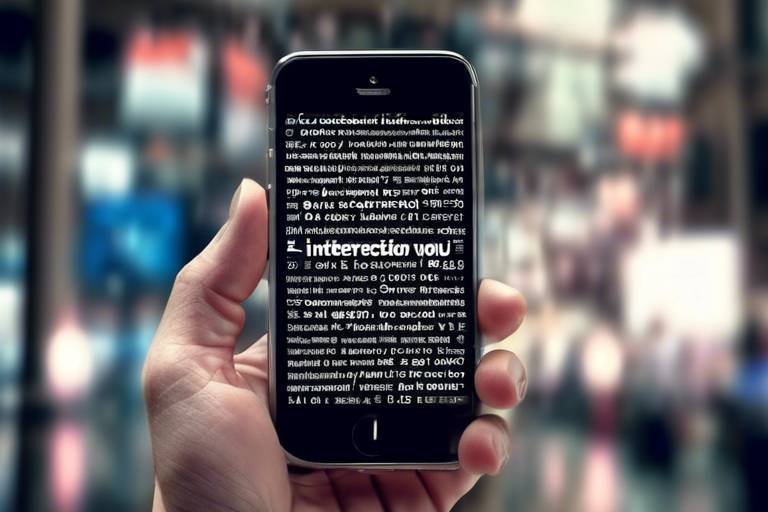The Intersection of Sociology and Technology
The world we live in today is a fascinating tapestry woven from the threads of sociology and technology. As these two fields intertwine, they create a complex interplay that shapes our social behaviors, cultural norms, and even the very structures of our society. Imagine for a moment that you’re at a bustling café, your eyes scanning the room filled with people, each absorbed in their own digital devices. This scene is a perfect representation of how technology has infiltrated our daily lives, altering the way we interact and connect with one another.
In this digital age, the impact of technology on society is not merely superficial; it penetrates deep into the fabric of our communities. From the way we communicate to how we form our identities, technology has become a pivotal force in shaping our social landscapes. Think about it: how often do you find yourself scrolling through social media, engaging with friends, or even meeting new people through online platforms? These interactions are not just fleeting moments; they are redefining our understanding of community and belonging.
Moreover, as we delve deeper into the implications of this intersection, we must consider the ethical dimensions that arise. For instance, how does the omnipresence of technology affect our privacy and autonomy? Are we becoming more connected, or are we merely exchanging one form of isolation for another? These questions are vital as we navigate the complexities of our modern world.
As we explore the nuances of sociology and technology, we can identify several key themes that emerge from their interaction:
- Transformation of Communication: The rise of social media has altered how we connect and communicate, leading to both positive and negative outcomes.
- Privacy Concerns: With increased surveillance and data collection, understanding the sociological implications of these practices is crucial.
- Digital Divide: The gap between those with access to technology and those without raises significant questions about equality and opportunity.
- Workplace Evolution: Technology is reshaping how we work, impacting job satisfaction and social interactions among employees.
- Virtual Communities: Online spaces provide new avenues for connection, yet they also challenge our notions of authenticity and belonging.
- Educational Transformation: The integration of technology in education influences teaching methods and student engagement.
- Social Movements: Digital platforms have revolutionized activism, facilitating the organization and mobilization of social movements.
As we move forward, the intersection of sociology and technology will continue to evolve, presenting both challenges and opportunities for research and practice. This article will delve into these themes, exploring how they shape our lives and what they mean for the future of society. So, buckle up as we embark on this intriguing journey through the digital age!
Below are some common questions about the intersection of sociology and technology:
- How does technology influence social interactions?
Technology alters how we communicate, often making interactions more convenient but sometimes less personal. - What are the privacy implications of technology?
Increased data collection and surveillance raise concerns about individual autonomy and trust in society. - What is the digital divide?
The digital divide refers to the gap between those who have access to technology and those who do not, impacting equality and opportunities. - How has technology changed the workplace?
Remote work and automation have reshaped labor dynamics, affecting job satisfaction and social interactions.

The Role of Social Media
Social media has revolutionized the way we communicate, transforming our interactions from face-to-face conversations to digital dialogues. Imagine a world where your best friend lives thousands of miles away, yet you can share a laugh over a meme or a heartfelt moment through a simple post. This is the magic of social media—it has created a tapestry of connections that transcends geographical boundaries. However, while it brings us closer, it also complicates our relationships and alters community dynamics in ways we are only beginning to understand.
At its core, social media serves as a platform for self-expression and connection. Users curate their online personas, sharing snippets of their lives that can foster a sense of belonging. But there’s a double-edged sword here. The quest for likes and shares can lead to a distorted sense of self-worth, where value is measured in followers rather than genuine connections. This phenomenon raises the question: Are we truly connecting, or are we merely performing for an audience?
Moreover, social media platforms have become breeding grounds for collective identity. They allow individuals to find like-minded communities, whether around hobbies, interests, or social causes. For instance, consider the rise of hashtags that unite voices for social justice. These digital rallying cries enable people to mobilize quickly and effectively, creating a sense of urgency and solidarity that traditional forms of activism often struggle to achieve. Yet, this rapid mobilization can sometimes lead to fleeting movements that lack depth and sustainability.
In addition to fostering connections, social media has also impacted our communication styles. The shift from lengthy emails to quick texts and tweets reflects a broader trend towards brevity and immediacy. This change has implications for how we articulate thoughts and feelings. Are we sacrificing depth for speed? In many cases, the nuanced conversations that once flourished in person have been replaced by emojis and abbreviations. While this can enhance engagement, it also raises concerns about miscommunication and the loss of meaningful dialogue.
Furthermore, social media has altered our perceptions of community. Traditional communities were often defined by physical proximity, shared experiences, and face-to-face interactions. Today, online communities can form around shared interests regardless of location. While this opens doors to diverse perspectives, it can also lead to echo chambers where dissenting opinions are drowned out. The challenge lies in navigating these spaces to foster genuine dialogue while respecting the diversity of thought.
In conclusion, the role of social media in shaping our social interactions and collective identity is profound. It has the power to connect us, empower movements, and redefine community. However, as we embrace these digital platforms, we must remain vigilant about the potential pitfalls, ensuring that our online interactions enrich rather than diminish our real-world relationships. The question we must continually ask ourselves is: How can we leverage social media to build authentic connections while navigating the complexities it introduces?
- How does social media influence our relationships?
Social media can enhance relationships by facilitating communication and connection, but it can also lead to superficial interactions and misunderstandings. - What are the negative impacts of social media on community dynamics?
Social media can create echo chambers that isolate users from differing viewpoints, potentially leading to polarized communities. - Can social media be a force for social change?
Absolutely! Social media has played a crucial role in organizing movements and raising awareness about social issues, allowing for rapid mobilization and support.

Impact on Privacy
In an era where technology permeates every facet of our lives, the has become a pressing concern. As we navigate through our digital experiences, we often overlook the vast amounts of data we generate daily. From social media interactions to online shopping habits, our personal information is continuously collected, analyzed, and often sold. This raises critical questions about individual autonomy and the very essence of our privacy.
To understand the sociological implications of this data collection, we must first consider the concept of surveillance capitalism. This term, popularized by Shoshana Zuboff, describes a new economic system where personal data is harvested to predict and influence our behavior. Imagine living in a world where your every move is tracked, not just by the government but by corporations eager to monetize your preferences. This reality is not far-off; it’s happening now. The ramifications of such surveillance extend beyond mere inconvenience—they challenge our notions of freedom and trust.
Furthermore, sociological perspectives shed light on the social contract between individuals and society. In the past, privacy was often seen as a fundamental right, a sanctuary from prying eyes. However, as technology evolves, we find ourselves in a paradoxical situation where many willingly exchange their privacy for convenience. This trade-off can lead to a diminished sense of security and a growing skepticism towards institutions that wield our data.
Consider the implications of surveillance on marginalized communities. These groups often bear the brunt of invasive monitoring practices, which can exacerbate existing inequalities. For instance, data collection methods may disproportionately target certain demographics, leading to a cycle of mistrust and disengagement from societal structures. The sociological lens helps us understand these dynamics, highlighting the need for equitable practices in technology deployment.
As we delve deeper into the effects of technology on privacy, it's essential to recognize the role of legislation and policy. Governments around the world are grappling with how to protect citizens in an age of rapid technological advancement. Laws like the General Data Protection Regulation (GDPR) in Europe aim to give individuals more control over their data. Yet, the effectiveness of such regulations remains a topic of debate. Are they sufficient to counterbalance the power held by tech giants? Or do they merely scratch the surface of a much deeper issue?
In conclusion, the intersection of sociology and technology reveals a complex web of interactions that significantly impact privacy. As we continue to embrace digital innovations, we must remain vigilant about the implications for our personal freedoms and societal norms. Understanding these dynamics is crucial for fostering a future where technology serves humanity, rather than undermines it.
- What is surveillance capitalism? Surveillance capitalism refers to an economic system where personal data is collected and used to predict and influence behavior, often without the individual's full awareness.
- How does technology affect privacy? Technology affects privacy by enabling extensive data collection, which can lead to invasive surveillance practices and a loss of individual autonomy.
- What are the implications for marginalized communities? Marginalized communities may face increased surveillance and data collection, exacerbating existing inequalities and leading to mistrust in societal institutions.
- Are current privacy laws effective? While laws like the GDPR aim to protect individual data rights, their effectiveness is still debated, especially in the face of rapidly evolving technology.

Digital Divide
The is more than just a techy buzzword; it's a profound issue that affects millions around the globe. Imagine living in a world where access to information, education, and even job opportunities hinges on something as simple as having a reliable internet connection. In today's fast-paced society, being connected is akin to having a lifeline. Yet, there exists a stark contrast between those who have easy access to technology and those who don’t. This gap is not just a technological issue; it’s a sociological crisis that can perpetuate inequality and hinder social mobility.
At its core, the digital divide can be categorized into two primary dimensions: access and usage. Access refers to the availability of technology and internet connectivity, while usage pertains to the skills and knowledge required to effectively utilize these resources. For instance, in urban areas, high-speed internet is often readily available, but in rural communities, it can be a luxury. This disparity can lead to a situation where those without access are left behind, unable to participate fully in the digital economy. The implications are staggering:
| Aspect | Impact of Digital Divide |
|---|---|
| Education | Students without internet access struggle to complete assignments and engage in remote learning. |
| Employment | Job seekers without digital skills face challenges in applying for jobs and participating in the gig economy. |
| Healthcare | Telehealth services are inaccessible to those without reliable internet, affecting health outcomes. |
| Social Participation | Exclusion from online communities limits social interaction and support networks. |
Furthermore, the digital divide is not just about infrastructure; it also encompasses social factors such as income level, education, and geographic location. For example, families with lower incomes may prioritize basic needs over technology, leading to a cycle of disadvantage. Similarly, individuals without formal education may lack the skills to navigate digital platforms, further widening the gap.
As we look to the future, addressing the digital divide requires a multifaceted approach. Governments, non-profits, and private sectors must collaborate to ensure equitable access to technology. This includes investing in infrastructure, providing digital literacy programs, and creating affordable options for low-income families. The goal should be to create a society where everyone has the tools they need to thrive in the digital age, fostering equality and opportunity for all.
- What is the digital divide? The digital divide refers to the gap between individuals who have easy access to digital technology and the internet and those who do not.
- Why is the digital divide important? It is crucial because it affects education, employment, healthcare, and social participation, ultimately impacting social equality.
- How can we bridge the digital divide? Bridging the digital divide requires investments in technology infrastructure, digital literacy education, and affordable access options for underserved communities.

Changing Work Environments
In today's fast-paced world, the driven by technology are reshaping our lives in ways we never imagined. Remember the days when commuting to an office was the norm? Now, with just a few clicks, many of us can work from the comfort of our homes. This shift isn't merely about convenience; it's a profound transformation that affects how we interact, collaborate, and even perceive our roles within organizations. The rise of remote work has blurred the lines between personal and professional spaces, leading to both opportunities and challenges.
One of the most significant changes we've seen is the impact of automation on job dynamics. Many tasks that used to require human intervention are now performed by machines or software, which can lead to increased efficiency but also raises questions about job security. It's like watching a game of chess where the pieces are constantly moving; just when you think you have a strategy, the rules change. As a result, workers must adapt quickly, acquiring new skills to remain relevant in an evolving job market.
Moreover, the shift to remote work has introduced a new layer of complexity in terms of social interactions among employees. While digital communication tools like Zoom and Slack have made it easier to connect, they can also create a sense of isolation. Imagine trying to build a rapport with someone you’ve only ever seen on a screen; it’s not the same as sharing a coffee break in the break room. Companies are now grappling with how to foster a sense of community and belonging in a virtual environment. This has led to innovative approaches such as virtual team-building exercises and online social events.
Additionally, the rise of flexible work hours has changed the traditional 9-to-5 workday. Many employees now enjoy the freedom to set their own schedules, which can lead to improved work-life balance. However, this flexibility can also blur the boundaries between work and personal life, as the expectation to be "always on" becomes more prevalent. It’s a double-edged sword; while some thrive in this new environment, others may struggle with the pressure to constantly perform.
To better understand these shifts, let’s take a look at a table summarizing some of the key changes in work environments:
| Aspect | Traditional Work Environment | Changing Work Environment |
|---|---|---|
| Location | Office-based | Remote/Hybrid |
| Work Hours | Fixed (9-to-5) | Flexible |
| Communication | Face-to-face | Digital (Video calls, chats) |
| Social Interaction | In-person | Virtual |
| Job Security | Stable, long-term | Dynamic, project-based |
In conclusion, the changing work environments driven by technology are creating a new landscape filled with both exciting opportunities and daunting challenges. As we adapt to these changes, it’s crucial to remain aware of their implications on our social interactions and overall well-being. The future of work is not just about technology; it’s about how we, as a society, navigate these transformations together.
Q: How has remote work impacted employee productivity?
A: Remote work can enhance productivity for many individuals by providing a more comfortable work environment and flexible hours, though it may also lead to distractions at home.
Q: What are the challenges of managing remote teams?
A: Challenges include maintaining effective communication, ensuring team cohesion, and monitoring employee performance without micromanaging.
Q: Will automation lead to job loss?
A: While automation may displace certain jobs, it also creates new opportunities that require different skill sets, emphasizing the need for continuous learning and adaptation.

Virtual Communities
In today's digital landscape, have become a cornerstone of social interaction. These online gatherings, whether they manifest as forums, social media groups, or gaming clans, allow individuals from diverse backgrounds to connect over shared interests, experiences, and goals. Imagine a bustling marketplace where people from around the globe come together to share ideas, support one another, and build relationships—this is what virtual communities offer. They break down geographical barriers, creating a sense of belonging and camaraderie among members who might never have crossed paths in the physical world.
However, while these communities can foster genuine connections, they also present unique challenges. The question arises: how do we ensure authenticity in a space where anonymity is prevalent? In virtual communities, it's easy for individuals to curate their identities, presenting polished versions of themselves that may not reflect reality. This can lead to feelings of inadequacy among those who compare their lives to the seemingly perfect lives of others online. Moreover, the lack of face-to-face interaction can sometimes hinder the development of deep, meaningful relationships, making it crucial for members to actively engage and participate to cultivate a sense of community.
Despite these challenges, the benefits of virtual communities are undeniable. They provide a platform for support, especially for marginalized groups who may struggle to find acceptance in traditional social settings. For example, LGBTQ+ individuals often find solace in online spaces where they can share their stories and seek advice without fear of judgment. Similarly, those dealing with specific health issues can connect with others facing similar challenges, creating a support network that can be incredibly empowering.
To illustrate the impact of virtual communities, consider the following table that highlights some key aspects:
| Aspect | Benefits | Challenges |
|---|---|---|
| Connection | Fosters relationships across distances | Risk of superficial interactions |
| Support | Provides emotional and informational support | Potential for misinformation |
| Identity | Allows for exploration and expression of self | Concerns over authenticity |
As we navigate the complexities of virtual communities, it’s essential to remain aware of their dual nature. They can be a source of strength and solidarity, but they can also lead to isolation and misunderstanding. Engaging mindfully in these spaces involves recognizing the importance of authenticity, empathy, and active participation. So, the next time you log into your favorite online platform, ask yourself: how can I contribute positively to my virtual community? How can I use this space to uplift others while also fostering genuine connections?
- What are virtual communities? Virtual communities are online spaces where individuals connect based on shared interests, experiences, or goals.
- How do virtual communities impact social relationships? They can enhance social connections but may also lead to superficial interactions if not engaged with mindfully.
- What challenges do virtual communities face? Issues such as authenticity, misinformation, and the potential for isolation are common challenges.
- How can I contribute positively to my virtual community? Engage actively, share authentic experiences, and support others to foster a nurturing environment.

Technology in Education
In today's fast-paced world, the integration of is nothing short of revolutionary. Imagine a classroom where students can access a wealth of information at the click of a button, or where teachers can tailor their lessons to meet the diverse needs of their students using digital tools. This is not just a dream; it’s a reality that is reshaping how we think about learning and teaching.
The impact of technology on education is profound and multifaceted. For instance, digital platforms like Google Classroom and Zoom have made it possible for learning to transcend geographical boundaries. Students from different parts of the world can collaborate on projects, share ideas, and gain insights from one another, fostering a sense of global community. But this shift isn’t just about connectivity; it’s also about engagement. Interactive tools such as educational apps and virtual reality (VR) experiences captivate students’ attention like never before, making learning not only informative but also enjoyable.
Moreover, technology has paved the way for personalized learning experiences. With the help of adaptive learning technologies, educators can analyze student performance data and customize their teaching strategies accordingly. This means that students who may struggle with certain concepts can receive additional resources and support tailored to their specific needs. In essence, technology is transforming the traditional one-size-fits-all approach into a more individualized and effective learning journey.
However, while the benefits are significant, there are also challenges that come with this technological shift. One of the pressing concerns is the digital divide. Not all students have equal access to the necessary devices or reliable internet connections, which can hinder their ability to engage fully with technology-enhanced learning. This disparity raises critical questions about equity in education and the need for policies that ensure all students can benefit from technological advancements.
Additionally, the role of technology in education extends beyond just the classroom. It is increasingly shaping how educational institutions operate. For example, administrative tasks such as enrollment, grading, and communication with parents are being streamlined through digital systems. This not only increases efficiency but also allows educators to focus more on what truly matters: teaching and nurturing their students.
As we look to the future, it is clear that technology will continue to play a crucial role in shaping education. The ongoing evolution of artificial intelligence (AI) and machine learning promises to bring even more innovative solutions to the educational landscape. Imagine AI-driven tutors that can assist students in real-time, providing instant feedback and support. The possibilities are endless, and they open up exciting avenues for research and development.
In conclusion, technology in education is not merely a trend; it is a fundamental shift that has the potential to enhance learning experiences, foster collaboration, and prepare students for a rapidly changing world. As we embrace these changes, it is essential to address the challenges and ensure that all learners have the opportunity to thrive in this new educational paradigm.
- How has technology changed the way students learn? Technology has made learning more interactive and personalized, allowing students to engage with material in diverse ways and at their own pace.
- What are some challenges of using technology in education? Challenges include the digital divide, where not all students have equal access to technology, and concerns about screen time and its impact on health.
- Will technology replace teachers? No, technology is meant to complement teachers, providing them with tools to enhance their teaching and support their students more effectively.
- What role does technology play in online learning? Technology is the backbone of online learning, enabling virtual classrooms, interactive content, and collaboration among students from different locations.

Social Movements and Technology
In today's fast-paced world, the intersection of social movements and technology has become a focal point for understanding how societal change occurs. The advent of digital platforms has revolutionized the way activists organize, mobilize, and communicate their messages. Gone are the days when social movements relied solely on traditional media and face-to-face gatherings. Instead, we now live in an era where a single tweet or a viral video can ignite a global conversation. Isn't it fascinating how a simple smartphone can empower individuals to challenge the status quo?
One of the most significant impacts of technology on social movements is the ability to reach a broader audience. With platforms like Twitter, Facebook, and Instagram, activists can share their narratives and rally support from people across the globe. This has led to the emergence of what we call "hashtag activism," where social issues gain traction through trending topics. For instance, movements such as #BlackLivesMatter and #MeToo have harnessed the power of social media to raise awareness and drive change. These hashtags not only connect individuals who share similar experiences but also create a collective identity that strengthens the movement.
However, while technology offers incredible opportunities for mobilization, it also presents challenges. The digital landscape can be a double-edged sword. On one hand, it allows for rapid dissemination of information; on the other hand, it can lead to misinformation and fragmentation of messages. Activists must navigate this complex environment carefully to ensure their voices are heard amidst the noise. This raises an important question: how do we maintain the authenticity of a movement in an age where information can be manipulated so easily?
Additionally, the role of technology in social movements extends beyond just communication. It also influences the strategies and tactics employed by activists. For example, the use of live streaming during protests has become increasingly common, allowing individuals to document events in real-time and share them with the world. This not only raises awareness but also serves as a form of accountability for law enforcement and other authorities. In this sense, technology acts as a powerful tool for transparency and justice.
Moreover, the global nature of the internet allows for cross-border solidarity among different movements. Activists can learn from one another, share strategies, and even collaborate on campaigns. This interconnectedness fosters a sense of global citizenship, where individuals recognize that their struggles are part of a larger tapestry of social justice issues. As we look to the future, it's clear that technology will continue to play a pivotal role in shaping the landscape of social movements.
In conclusion, the relationship between social movements and technology is complex and multifaceted. While technology has undoubtedly enhanced the ability to organize and mobilize, it also poses challenges that activists must navigate carefully. As we continue to witness the evolution of social movements in the digital age, one thing remains certain: the power of collective action, amplified by technology, can drive meaningful societal change.
- How has technology changed the way social movements are organized?
Technology has enabled activists to reach a wider audience, share information rapidly, and coordinate actions more effectively through digital platforms. - What are some examples of successful social movements that used technology?
Movements like #BlackLivesMatter and #MeToo have successfully utilized social media to gain visibility and support, leading to significant societal discussions and changes. - What challenges do social movements face in the digital age?
Challenges include misinformation, maintaining message authenticity, and the potential for online activism to overshadow traditional forms of organizing.

Future Trends and Predictions
As we look ahead, the intersection of sociology and technology is set to evolve in ways that could reshape our understanding of society. With the rapid pace of technological advancement, we can expect significant shifts in how we interact, communicate, and organize our lives. One of the most exciting trends is the rise of artificial intelligence (AI) and machine learning, which are not only enhancing productivity but also altering the very fabric of social interactions. Imagine a world where AI personal assistants are not just tools but companions, influencing our daily decisions and social engagements.
Moreover, the concept of smart cities is gaining traction. These urban areas leverage technology to improve the quality of life for residents, from optimizing traffic flow to enhancing public safety. However, the sociological implications of such advancements raise important questions: Will these technologies create more inclusive communities, or will they exacerbate existing inequalities? As we integrate technology into the urban landscape, we must remain vigilant about the potential for surveillance and the erosion of privacy.
Another crucial trend is the increasing importance of digital literacy. As technology becomes more embedded in our lives, the ability to navigate digital spaces effectively will be essential. This shift highlights the need for educational systems to adapt, ensuring that all individuals, regardless of socioeconomic status, have access to the skills necessary to thrive in a tech-driven world. The digital divide is not just a matter of access; it’s about equipping people with the tools to participate fully in society.
Furthermore, the evolution of remote work is likely to continue, reshaping our notions of employment and community. The pandemic has already accelerated this trend, and as companies embrace flexible work arrangements, we must consider how this affects social interactions among colleagues. Will remote work lead to a more isolated workforce, or can technology foster new forms of collaboration and connection? The answer may lie in how organizations choose to leverage digital tools to maintain a sense of community.
Lastly, we must acknowledge the role of social movements in the digital age. As technology enables grassroots activism, we see a transformation in how social issues are brought to the forefront. Movements like #MeToo and Black Lives Matter have utilized social media to amplify their messages, demonstrating the power of digital platforms in shaping public discourse. However, this raises questions about the sustainability of online activism and its impact on real-world change. Are we witnessing a genuine shift in societal norms, or is it merely a digital echo chamber?
In conclusion, the future of sociology and technology is a landscape filled with both opportunities and challenges. As we navigate this terrain, it’s essential to remain critical and reflective about the implications of these changes. By fostering a dialogue between sociologists, technologists, and the public, we can work towards a future that embraces innovation while prioritizing social equity and community well-being.
- What is the impact of technology on social interactions?
Technology has transformed how we communicate, often leading to more superficial connections but also creating new opportunities for meaningful engagement through online communities. - How can we bridge the digital divide?
Efforts to bridge the digital divide include increasing access to technology, providing digital literacy training, and ensuring equitable internet access for all communities. - Will remote work become the new norm?
While remote work is likely to continue, its permanence will depend on organizational culture and the effectiveness of digital collaboration tools in fostering team dynamics. - How does technology influence social movements?
Technology plays a crucial role in organizing and mobilizing social movements, enabling activists to reach a wider audience and coordinate efforts more efficiently.
Frequently Asked Questions
- How has social media changed the way we communicate?
Social media has revolutionized communication by enabling instant interactions across vast distances. It fosters connections that transcend geographical boundaries, allowing people to share experiences and ideas in real-time. However, it also raises questions about the quality of these interactions and whether they truly replace face-to-face communication.
- What are the privacy concerns associated with technology?
With the rise of technology, particularly in data collection and surveillance, privacy has become a significant concern. Sociological perspectives help us understand how these practices impact individual autonomy and societal trust. People often feel their personal information is vulnerable, leading to a sense of unease in a digitally connected world.
- What is the digital divide, and why is it important?
The digital divide refers to the gap between individuals who have access to technology and those who do not. This divide can exacerbate existing inequalities in education, employment, and social engagement. Understanding its implications is crucial for promoting equality and ensuring that everyone has the opportunity to benefit from technological advancements.
- How is technology changing work environments?
Technology is transforming workplaces by enabling remote work and automation. This shift affects labor dynamics, job satisfaction, and the social interactions among workers. While remote work offers flexibility, it can also lead to feelings of isolation, highlighting the need for a balance between technology and human connection.
- What role do virtual communities play in society?
Virtual communities have become vital social spaces where people connect, share interests, and find support. These online environments can foster a sense of belonging, but they also present challenges regarding authenticity and the nature of relationships formed online. It's essential to navigate these complexities to maintain genuine connections.
- How is technology impacting education?
The integration of technology in education has transformed teaching methods and student engagement. Digital tools enhance the learning experience, making it more interactive and accessible. However, educators must also consider the challenges of ensuring that all students can effectively utilize these technologies.
- How does technology facilitate social movements?
Technology plays a crucial role in organizing and mobilizing social movements by providing platforms for activism. Social media and other digital tools help raise awareness, connect like-minded individuals, and drive collective action. This has a significant sociological impact, as it can lead to substantial societal change.
- What are the future trends at the intersection of sociology and technology?
As technology continues to evolve, so will its relationship with sociology. Future trends may include an increased focus on ethical considerations in technology use, the impact of artificial intelligence on social structures, and the ongoing exploration of digital identities. Researchers and practitioners will need to adapt to these changes to address emerging challenges and opportunities.



















